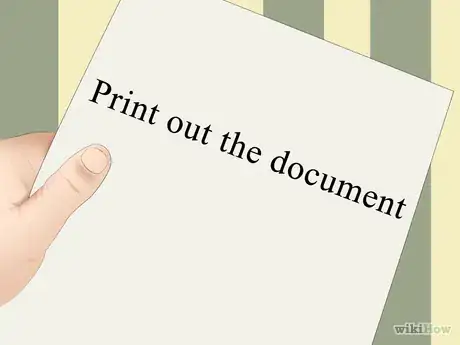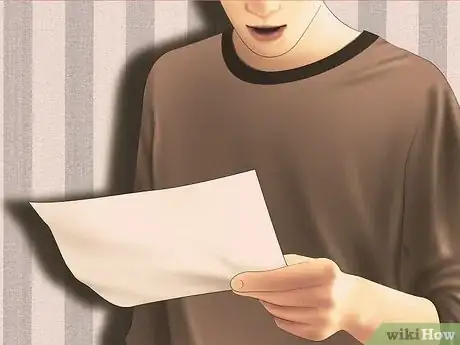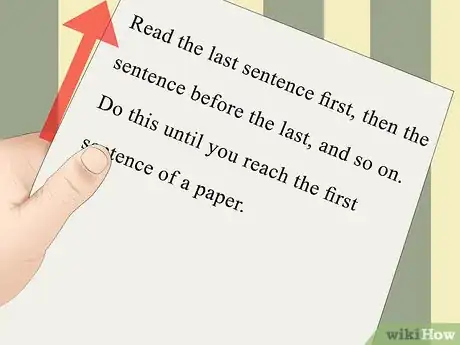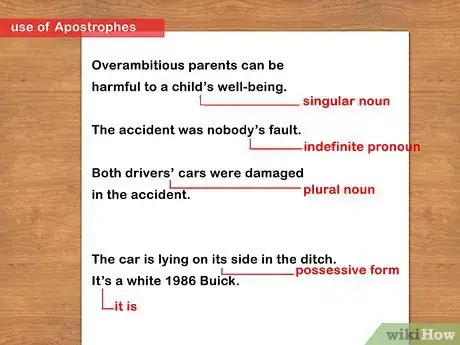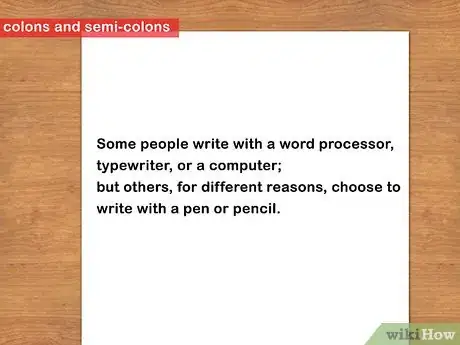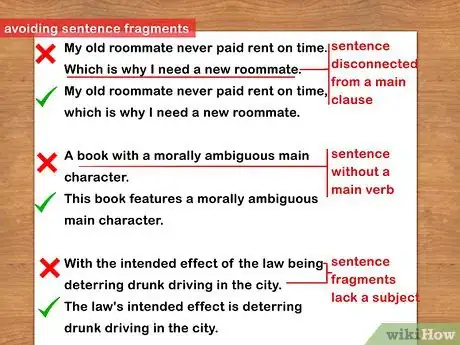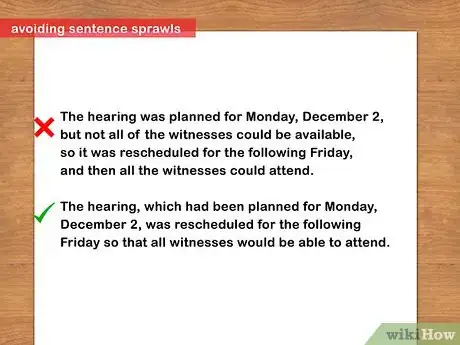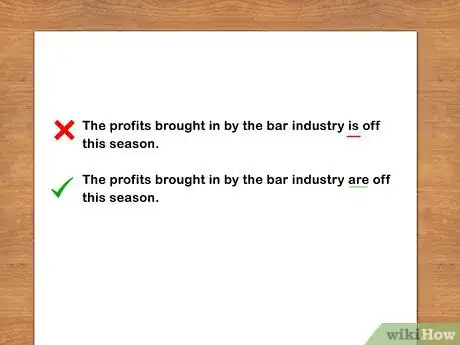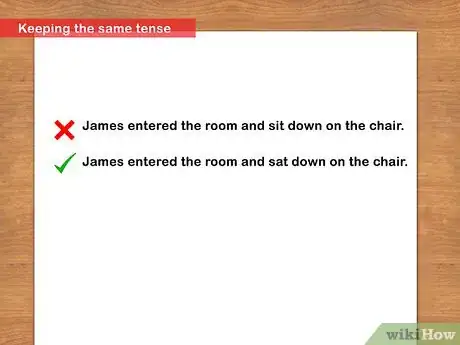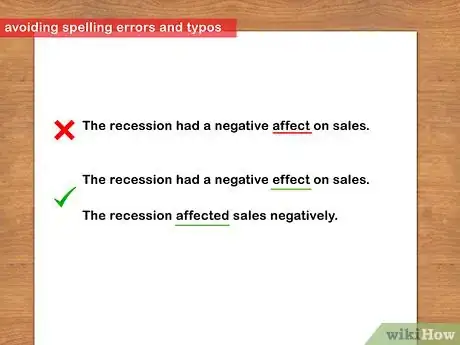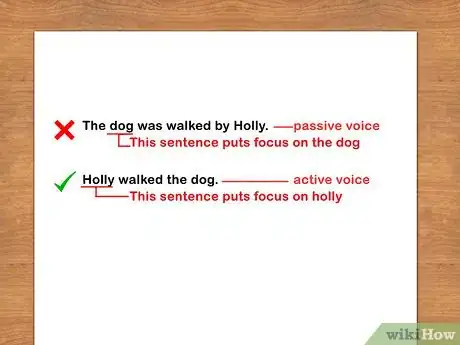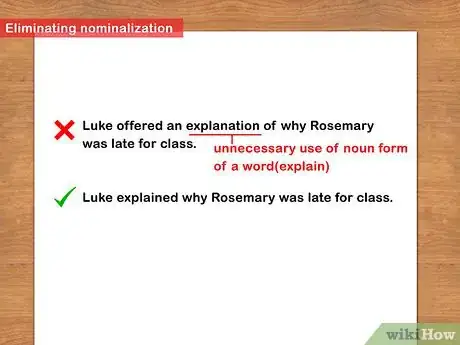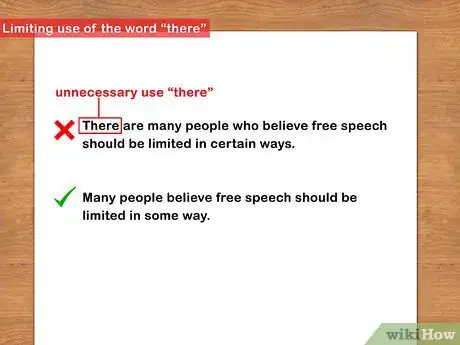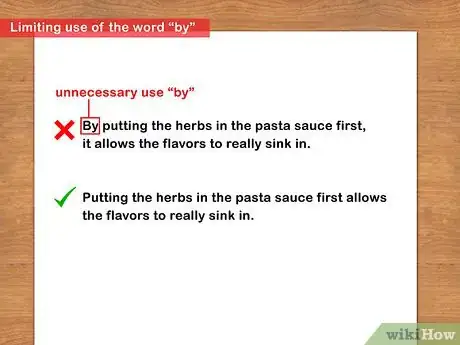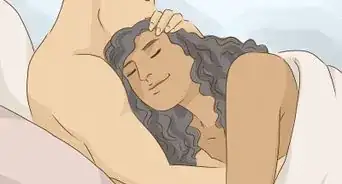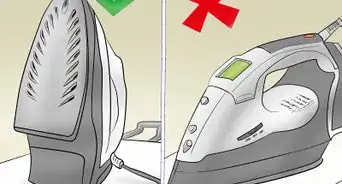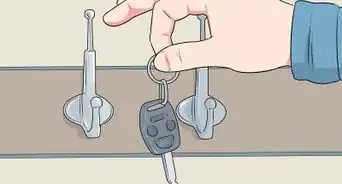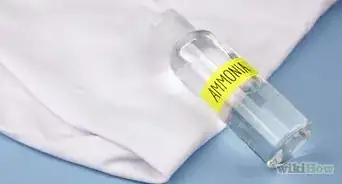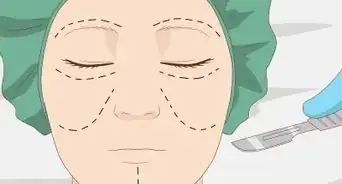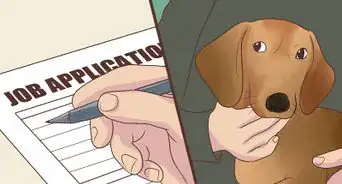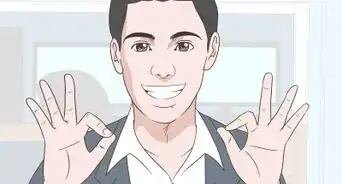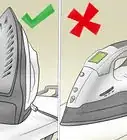X
This article was co-authored by Megan Morgan, PhD. Megan Morgan is a Graduate Program Academic Advisor in the School of Public & International Affairs at the University of Georgia. She earned her PhD in English from the University of Georgia in 2015.
There are 9 references cited in this article, which can be found at the bottom of the page.
This article has been viewed 57,605 times.
Proofreading, or reading written work for errors in spelling, punctuation and grammar, is an important element of editing. Mistakes in punctuation, grammar, spelling, and style can lead to a confusing and hard to read paper. If you read slowly and watch for common errors, you can successfully proofread a work.
Steps
Method 1
Method 1 of 4:
Catching Errors in Your Own Work
-
1Set the text aside. It is very common to miss mistakes when editing your own work, especially if you've just written it. You end up reading for what's in your head and not what's written down on paper. Setting a work aside for a day or so can allow you to get the space you need to spot errors.[1]
- Ideally, the longer you set a text aside, the better. A day or more might be a good idea. However, if you're working on a deadline you might not have that much time. Try to at least set the text aside for half and hour or 15 minutes before revisiting it.[2]
-
2Print out the document or alter its look. Anything you can do to make a text look different can help you spot errors more easily. Altering the text or seeing it in a different medium can help with the proofreading process.
- Ideally, you should print the text out. Not only can reading a text on paper rather than a screen help with proofreading, you'll also be able to use a pen or pencil to mark any errors you see as you go.[3]
- It's not always possible to print out a text, however. If you do not have a printer handy, you may have to proofread on a screen. If this the case, try altering the look of the document. Change the font's type, color, or size. Copy and paste the text into an e-mail document, send it to yourself, and then read it online.[4]
-
3Read the paper out loud. Sometimes, hearing the text out loud can help you catch errors in the text. In a quiet room, read the text as you go along. Try to pay attention to what's written and not what's in your head as you read. Go slowly, focusing on each individual sentence. You might also want to take a pencil or chop stick and tap each word as you go, as this will force you to focus on what's written and not what's in your head.[5]
-
4Read the work backwards. Changing the order of a text can help you catch errors. Much like proofreading, this changes how you look at the text and can help you read what's written and not what's in your head.
- Read the last sentence first, then the sentence before the last, and so on. Do this until you reach the first sentence of a paper.[6]
Method 2
Method 2 of 4:
Correcting Punctuation
-
1Watch out for apostrophes. Many people accidentally misuse apostrophes in their writing. Each time you see an apostrophe used, take a moment to make sure it's used correctly.
- Apostrophes are used to show possession. To show something belongs to someone, you would use an apostrophe and then an "s" or an apostrophe after an "s." An apostrophe and then an "s" is used for singular nouns, indefinite pronouns (anybody, somebody, etc.), and plural nouns that do not end in "s" (fish, deer, etc.). An apostrophe following an s is only used for plural pronouns that end in an "s."[7]
- For example, "I asked if I could pet the man's dog." As "man" is a singular noun, the apostrophe comes before the "s." In the sentence, "All the students' papers were turned in late," the apostrophe comes after the "s" as students is plural and ends in "s."
- The word "it" is an exception. If it is possessive, it's spelled "its." The construction "it's" is a contraction, meaning "it is." For example, "The dog is chewing on its toy. It's a black Labrador."[8]
-
2Make sure colons and semi-colons are used correctly. Semi-colons and colons are often used incorrectly or used in place of one another. Each time you see one of the two used, pause to make sure the usage is correct.
- Semi-colons are usually used to connect closely related ideas when a comma is not appropriate. Semi-colons can link independent clauses, clauses connected by transitional phrases or conjunctive adverbs, or lengthy clauses with multiple commas in each clause to avoid confusion. Usually, semi-colons should be used between two clauses that could stand on their own independently.[9]
- A common error regarding semi-colons is using a comma when a semi-colon would be appropriate. For example, "The dog is big, it is also brown." As there is no conjunction connecting those two clauses, and the ideas are connected, a semi-colon would be more effective here. "The dog is big; it is also brown."[10]
- Another common error regarding semi-colons is using one in place of a colon. A colon is used to say, "that is to say" or "here is what I mean." It's most commonly used before lists in a sentence. For example, "Jane went to the store and bought everything she needed for the cookies: spices, sugar, flour, and icing."[11]
- A colon can also be used much the same way a semi-colon is used, to connect two clauses, but only if specific requirements are met. A colon should only be used in place of a semi-colon if the second clause explains the first. For example, "Mark's long career in law paid off: he was elected district judge that year." As the second clause explains what the first was alluding to, Mark's election as judge being what his law career lead to, a colon is appropriate.
- Two ideas that are merely connected would still require a semi-colon. For example, "Mark got to the courthouse at noon; he put on his judge's robes." As the robes do not offer an explanation for the first clause, a semi-colon is used.[12]
-
3Fix comma splices. Commas are one of the most misused forms of punctuation. While proofreading a paper, watch out for comma splices.
- Read through your paper and take note of every use of a comma. For example, take the sentence, "Eve went to the drugstore, she picked up a prescription for painkillers." Read the first part of the sentence. Does it make sense on its own? Yes. Read the second part. That also makes sense on its own. This is a comma splice and the error should be corrected.
- There are three ways to fix a comma splice. You could add a conjunction that merges the sentences together. For example, "Eve went to the drugstore and picked up a prescription for painkillers" or "Eve went to the drugstore to pick up a prescription for painkillers."
- Second, you could replace the comma with a period and make two sentences. "Eve went to the drugstore. She picked up a prescription for painkillers."
- Third, you could replace the comma with a semicolon if the sentences are closely related. "Eve went to the drugstore; she picked up a prescription for painkillers."
Method 3
Method 3 of 4:
Eliminating Grammar Errors
-
1Watch for sentence fragments. A sentence fragment is a statement with a period, question mark, or some form of punctuation that fails to stand on its own as a sentence.
- Fragments are most often a piece of a sentence disconnected from a main clause. For example, "My old roommate never paid rent on time. Which is why I need a new roommate." The second part of that thought is a sentence fragment. It can be corrected by merging the two. "My old roommate never paid rent on time, which is why I need a new roommate."[13]
- Sentence fragments can also be a sentence without a main verb. For example, "A book with a morally ambiguous main character." This tells about the book and its characters, but there's no action happening which means it is not a full sentence. A possible revision would be, "This book features a morally ambiguous main character" the verb becoming "features."[14]
- Sometimes, sentence fragments lack a subject. For example, "With the intended effect of the law being deterring drunk driving in the city." The subject is unclear. A revision might be, "The law's intended effect is deterring drunk driving in the city."[15]
-
2Break down run-on sentences. Run-on sentences can be somewhat difficult to detect as they can sometimes appear grammatically correct if not read closely. Run-on sentences are very long sentences when two or more clauses are joined without the use of a comma, semi-colon, conjunction, or other means of connecting sentences.[16]
- A good way to detect run-on sentences is to read a work out loud. Listen to your own voice. If you find the sentence difficult to finish in a single breath, and if you find it's hard to follow when spoken out loud, it might be a run-on sentence.
- A run-on sentence can usually be corrected through the use of a comma, semi-colon, or other device to unite the two sentences. For example, "My favorite movie is It's A Wonderful Life it is a very heartwarming Christmas story." This is a run-on sentence as the two clauses ("My favorite movie...", "it is a...") are not properly connected. It could be fixed in a number of ways.
- You could break down the run-on into two sentences. "My favorite movie is It's A Wonderful Life. It is a very heartwarming Christmas story." You could use a semi-colon, as the ideas are connected. "My favorite movie is It's A Wonderful Life; it's a very heart warning Christmas movie." You could also use a conjunction to unite the clauses. "My favorite movie is It's A Wonderful Life because it's a heartwarming Christmas story."
-
3Watch for sentence sprawls. Sentence sprawls are very long sentences that, while usually technically grammatically correct, can be difficult to read. Some writers use sentence sprawls stylistically, but unless a sentence sprawl is intentional and meant to convey something to the reader you should minimize their use. In general, if you notice a very long sentence that takes up more than two lines, try to break it up into multiple sentences.[17]
-
4Make sure the subject and verb of each clause agree. Subject/verb agreement means singular subjects have singular verbs, and plural subjects have plural verbs. People sometimes make mistakes with S/V agreement when writing sentences with multiple clauses or longer sentences as they lose track of what the subject was.
- In some sentences, the subject appears before another noun and you may accidentally have the verb agree with the second noun over the actual subject. For example, take the sentence "The profits brought in by the bar industry is off this season." At first glance, this may appear correct as "is" comes after "bar industry." However, the subject of the sentence is "the profits," not the bar. Therefore, the correct construction would be "The profits brought in by the bar industry are off this season."[18]
- When joining two singular subjects with a conjunction like "and", the verb should be plural even though the subjects themselves are singular. For example, "Mary and her friend takes the train into the city each day" is incorrect as both "Mary" and "her friend" are singular nouns, but they are presented as a plural unit. The correct construction would be "Mary and her friend take the train into the city each day."[19]
-
5Keep the same verb tense throughout the sentence or passage. Shifting between present and past tense may confuse the reader. Make sure your verb tense is always in agreement.
- People often slip up by mistake with tense agreement, especially when typing quickly. Past and present tense verbs are often spelled in similar ways, leading you to make an error. For exampled, "James entered the room and sit down on the chair." As "sit" and "sat" differ only by one letter, this is an easy mistake to make. The sentence should be, "James entered the room and sat down on the chair."
-
6Watch for basic spelling errors and typos. Even people generally good with spelling and grammar occasionally make mistakes.
- Dropped words are a common typo. You may forget the "is" or "the" in a sentence if you worked too quickly. Reading a work out loud can help you catch dropped words.
- Do not rely solely on spellcheck. Spellcheck can be a helpful feature but it does not catch all spelling and grammar errors. If, for example, you typed "quite" instead of "quiet" spellcheck would not catch this error.
- Know what words you tend to misspell. Words like "unnecessary," for example, can trip people because of the multiple letters. Keep a running list of words you frequently stumble over and pay attention to their use in your paper.
Method 4
Method 4 of 4:
Proofreading for Stylistic Problems
-
1Watch for passive voice. Using passive voice is generally advised against unless you work in a few specific disciplines. Watch for the passive voice as you edit your work.
- The subject of a sentence should be the person, place, or thing doing the action. This is called the active voice and you should generally use the active when writing.
- In the passive voice, some form of the verb "to be" (e.g., is, are, was, were) is used with a past participle (a verb in the past tense). This can be needlessly confusing to read and takes attention away from the action, which should be the primary focus of a sentence.
- For example, take the sentence "The dog was walked by Holly." This sentence is in the passive voice. To correct it, you would change it to, "Holly walked the dog." This sentence puts focus on the person engaging in the action (Holly) rather than the objected acted upon (the dog).
-
2Eliminate nominalization. Nominalization is unnecessarily using the noun form of a word when the verb form would make the sentence more concise. People often accidentally nominalize a sentence in a first draft.
- To catch unneeded nominalization, look for the word "of" and examine each time you use it in a paper. "Of" is often used in nominalization. For example, "Luke offered an explanation of why Rosemary was late for class."
- As you can see in the above sentence, instead of using the verb "explain" the noun "explanation" is used. The sentence would be quicker and easier to read if it were rewritten as "Luke explained why Rosemary was late for class."
-
3Limit use of the word "there." "There" is an expletive that usually does nothing to clarify the meaning of a sentence. In general, you should remove unnecessary uses of the word "there" while proofreading.
- Sentences that begin with "there," "there is," and "there are" would generally read better with these portions removed. For example, "There are many people who believe free speech should be limited in certain ways." Removing the "there" makes the sentence read more smoothly. "Many people believe free speech should be limited in some way."
-
4Correct "By...it" constructions. These constructions are unnecessarily long sentence that begin with "by" and use the word "it" somewhere in the middle. For example, ""By putting the herbs in the pasta sauce first, it allows the flavors to really sink in" could be made more concise by simply saying "Putting the herbs in the pasta sauce first allows the flavors to really sink in."
Community Q&A
-
QuestionYou mentioned in method #2 that we can use a colon if the second thought explains the former. Why didn't you use it in method #3-2: "My favorite movie is..."?
 DonaganTop AnswererIn the first instance the second thought is an explanation or an expansion of the first thought. In the second instance there's just one thought being completed by the second part of the sentence.
DonaganTop AnswererIn the first instance the second thought is an explanation or an expansion of the first thought. In the second instance there's just one thought being completed by the second part of the sentence. -
QuestionWhy is passive voice bad?
 DonaganTop AnswererIt's not necessarily bad, but passive voice is often considered a weaker or less interesting sentence construction than active voice.
DonaganTop AnswererIt's not necessarily bad, but passive voice is often considered a weaker or less interesting sentence construction than active voice.
References
- ↑ http://www.quickanddirtytips.com/education/grammar/proofreading-tips
- ↑ https://writing.wisc.edu/Handbook/Proofreading.html
- ↑ https://writing.wisc.edu/Handbook/Proofreading.html
- ↑ https://writing.wisc.edu/Handbook/Proofreading.html
- ↑ https://writing.wisc.edu/Handbook/Proofreading.html
- ↑ https://writing.wisc.edu/Handbook/Proofreading.html
- ↑ http://www.indiana.edu/~wts/pamphlets/proofing_grammar.shtml#apostrophes
- ↑ http://www.indiana.edu/~wts/pamphlets/proofing_grammar.shtml#apostrophes
- ↑ https://writing.wisc.edu/Handbook/Semicolons.html
- ↑ https://writing.wisc.edu/Handbook/Semicolons.html
- ↑ http://www.grammarbook.com/punctuation/colons.asp
- ↑ http://www.grammarbook.com/punctuation/colons.asp
- ↑ https://owl.english.purdue.edu/owl/resource/620/1/
- ↑ https://owl.english.purdue.edu/owl/resource/620/1/
- ↑ https://owl.english.purdue.edu/owl/resource/620/1/
- ↑ http://writingcenter.unc.edu/handouts/fragments-and-run-ons/
- ↑ https://writing.wisc.edu/handbook/grammarpunct/commonerrors/
- ↑ http://www.indiana.edu/~wts/pamphlets/proofing_grammar.shtml#agreement
- ↑ http://www.indiana.edu/~wts/pamphlets/proofing_grammar.shtml#agreement

